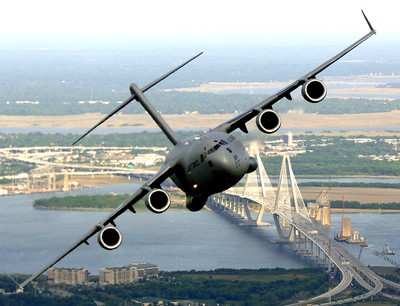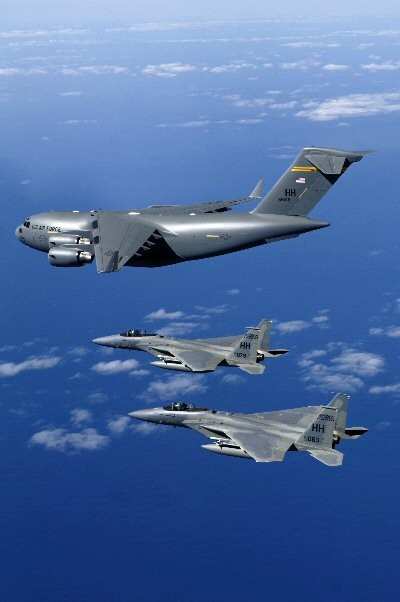Maintenance Function Transferred To Tinker In 2010
Airmen from the 76th Propulsion Maintenance Group and Pratt
& Whitney mechanics recently completed repairs on the first
F117 engine of the newly-obtained workload at Tinker AFB. The Pratt
& Whitney manufactured engine powers the C-17 Globemaster
III.

"The significance is that this engine was the first ever
produced in partnership with an original equipment manufacturer,
Pratt & Whitney," said Col. Robert Helgeson, the 76th PMXG
commander. "Additionally, production of this engine qualifies and
certifies (Tinker Air Force Base's F117 Heavy Maintenance Center)
is capable to produce quality and conforming engines for the C-17
fleet."
The Heavy Maintenance Center at Tinker AFB opened in June 2010,
after three years of planning. The work consists mostly of
on-condition maintenance, meaning when field personnel determine an
engine isn't operating as efficiently as possible or there is
something physically wrong with it, the engine is sent in for
repair, officials said. Through the partnership, the Oklahoma City
Air Logistics Center provides floor space, equipment and touch
labor while Connecticut-based Pratt & Whitney supplies repair
instructions, engineering support, supply chain management and
repair supplies, officials said.
Once the workload matures, engines are expected to arrive at the
facility every two to three days, and technicians will fix each
engine in an estimated 60 days, officials said. Due to the learning
curve, the first engine took several months to finish, but
officials said they expect the gap to close as technicians become
more experienced. When engines leave Tinker, they are routed to
Charleston AFB, S.C., for testing. If they pass, they are installed
onto aircraft. If engines fail the testing, they are returned to
Tinker for further repair. Through the next five to six months,
testing capabilities are expected to be relocated to the Oklahoma
base, said Leonard Hayes, the 76th PMXG engine business office
depot activation manager.

Measuring 13-feet wide and 24-feet long, and weighing
approximately 10,000 pounds, the F117 is the largest engine
repaired at the Oklahoma City Air Logistics Center, he said. A
single engine produces approximately 41,000 pounds of thrust, which
is nearly twice the thrust produced by an E-3 Sentry's TF33 engine.
Four F117 engines power each C-17, enabling it to reach speeds of
450 mph. There are more than 1,000 F117 engines in the fleet, and
base officials are expected to handle about one-third of the
workload, Mr. Hayes said. "These engines are being used all the
time," Mr. Hayes said. "Anytime anything goes across the ocean, it
almost always flies on one of these aircraft. These aircraft are
also used for in-theater transport."
Currently there are 30 mechanics in the shop able to work on
four engines, but that too is expected to change, he said. Later
this year, after the 45,000 square-foot shop is expanded to 96,000
square feet, the facility is expected to be able to accommodate six
to ten engines at a time, with up to 150 technicians assigned to
the workload.
Officials at the C-17 Program Office at Warner-Robins Air
Logistics Center, GA, will invest approximately $43.6 million in
the facility and equipment, he said. Within the next two years,
management for the engine will be transferred to Oklahoma City, but
the airframe will still be supported at Warner-Robins Air Logistics
Center.

"This sets up the ALC with a long-term workload," Hayes said.
"As other engines are beginning to decline, there will still be a
steady work requirement, and we'll be better set up for its way
forward."
 ANN's Daily Aero-Linx (04.15.24)
ANN's Daily Aero-Linx (04.15.24) Classic Aero-TV: 'No Other Options' -- The Israeli Air Force's Danny Shapira
Classic Aero-TV: 'No Other Options' -- The Israeli Air Force's Danny Shapira Aero-News: Quote of the Day (04.15.24)
Aero-News: Quote of the Day (04.15.24) Airborne 04.16.24: RV Update, Affordable Flying Expo, Diamond Lil
Airborne 04.16.24: RV Update, Affordable Flying Expo, Diamond Lil ANN's Daily Aero-Term (04.16.24): Chart Supplement US
ANN's Daily Aero-Term (04.16.24): Chart Supplement US





